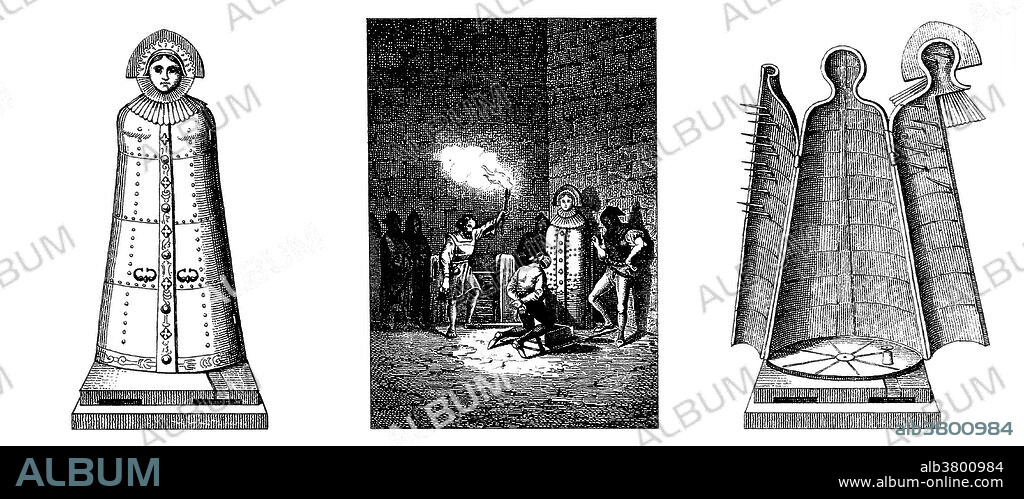alb3800984
Iron Maiden, Fictional Torture Device

|
Añadir a otro lightbox |
|
Añadir a otro lightbox |



¿Ya tienes cuenta? Iniciar sesión
¿No tienes cuenta? Regístrate
Compra esta imagen

Título:
Iron Maiden, Fictional Torture Device
Descripción:
Traducción automática: A la izquierda, una doncella de hierro con las puertas aseguradas; en medio, un prisionero con los ojos vendados es obligado a arrodillarse ante la doncella de hierro en una mazmorra; a la derecha, una doncella de hierro con las puertas abiertas. La doncella de hierro (también conocida como jungfernkuss, eiserne jungfrau, la virgen, el beso de la virgen) es un dispositivo de tortura de gabinete de hierro ficticio con un frente con bisagras y un interior cubierto de púas para encerrar a un ser humano. Wolfgang Schild, profesor de derecho penal e historia del derecho penal en la Universidad de Bielefeld, ha argumentado que las supuestas doncellas de hierro se ensamblaron a partir de artefactos encontrados en museos para crear objetos espectaculares destinados a la exhibición. Es poco probable que alguna de estas doncellas de hierro haya sido empleada alguna vez como instrumento de tortura. Las doncellas de hierro del siglo XVII pueden haber sido construidas como una probable interpretación errónea de un Schandmantel medieval (escudo de la vergüenza o barril de la vergüenza), que estaba hecho de madera y metal pero sin púas. La inspiración para la doncella de hierro también puede provenir de la ejecución cartaginesa de Marcus Atilius Regulus, quien "lo metió en una caja de madera apretada, con clavos afilados en todos los lados para que no pudiera inclinarse en ninguna dirección sin ser perforado". La doncella de hierro más famosa que popularizó el diseño fue la de Nuremberg, exhibida por primera vez en 1802. El original se perdió en el bombardeo aliado de Nuremberg en 1944. Grabado sin fecha
Left, an iron maiden with its doors secured; middle, a blindfolded prisoner is forced to kneel down before the iron maiden in a dungeon; right, an iron maiden with its doors open. The iron maiden (AKA, jungfernkuss, eiserne jungfrau, the virgin, kiss of the virgin) is a fictional iron cabinet torture device with a hinged front and spike-covered interior to enclose a human being. Wolfgang Schild, a professor of criminal law and criminal law history at the University of Bielefeld, has argued that putative iron maidens were pieced together from artifacts found in museums to create spectacular objects intended for exhibition. It is unlikely that any of these iron maidens were ever employed as instruments of torture. The 17th century iron maidens may have been constructed as probable misinterpretation of a medieval Schandmantel (coat of shame or barrel of shame), which was made of wood and metal but without spikes. Inspiration for the iron maiden may also have come from the Carthaginian execution of Marcus Atilius Regulus, who "packed him into a tight wooden box, spiked with sharp nails on all sides so that he could not lean in any direction without being pierced". The most famous iron maiden that popularized the design was that of Nuremberg, first displayed as far back as 1802. The original was lost in the Allied bombing of Nuremberg in 1944. Undated etching.
Crédito:
Album / Science Source / Wellcome Images
Autorizaciones:
Modelo: No - Propiedad: No
¿Preguntas relacionadas con los derechos?
¿Preguntas relacionadas con los derechos?
Tamaño imagen:
5700 x 2480 px | 40.4 MB
Tamaño impresión:
48.3 x 21.0 cm | 19.0 x 8.3 in (300 dpi)
Palabras clave:
ARTE • BLANCO Y NEGRO • CASTIGAR • CASTIGO • CRUEL • CRUELDAD • DAMA DE HIERRO • EJECUCION • HISTORIA • HISTORICO • ILUSTRACION • INSTRUMENTO TORTURA • METODO TORTURA • MÍTICO • MITO • PERSECUCION • VERDUGO • VIRGEN, LA
 Pinterest
Pinterest Twitter
Twitter Facebook
Facebook Copiar enlace
Copiar enlace Email
Email
